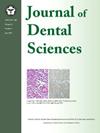Nucleotide-binding oligomerization domain-like receptor family caspase recruitment domain containing protein 5 affects the progression of periodontitis by regulating the function of periodontal membrane cells
IF 3.4
3区 医学
Q1 DENTISTRY, ORAL SURGERY & MEDICINE
引用次数: 0
Abstract
Background/purpose
Nucleotide-binding oligomerization domain-like receptor family caspase recruitment domain containing protein 5 (NLRC5) plays a regulatory role in innate and adaptive immunity. However, its role in periodontitis remains unclear. This study investigated the effects of NLRC5 on periodontitis and the underlying mechanism.
Materials and methods
Experimental periodontitis models of wild-type and Nlrc5 knockout mice were established to detect alveolar bone loss. The inflammatory environment was established with Porphyromonas. gingivalis lipopolysaccharide (P. gingivalis LPS). The expression of NLRC5 in periodontal ligament stem cells (PDLSCs) were detected with P. gingivalis LPS stimulated. After knocking-down or overexpressing the NLRC5 expression level, the inflammatory cytokine level and osteogenic ability of PDLSCs were detected.
Results
The Nlrc5 knockout mice exhibited greater alveolar bone loss in periodontitis. In the presence of P. gingivalis LPS, the expression of NLRC5 decreased. Downregulating NLRC5 increased the expression of interleukin (IL)-1β, IL-6 and tumor necrosis factor-α (TNF-α). Upregulated NLRC5 inhibited nuclear factor kappa-B (NF-κB) signaling and inhibited the expression of those proinflammatory factors. NLRC5 had a positive regulatory effect on the osteogenic differentiation of PDLSCs. When NLRC5 was knocked down, the ALP activity and the number of mineralized nodules in PDLSCs decreased. Conversely, overexpression of NLRC5 enhanced the osteogenic differentiation ability of PDLSCs. Overexpression of NLRC5 increased the osteogenic differentiation of PDLSCs in inflammatory environments.
Conclusion
NLRC5 affects the progression of periodontitis by regulating the function of PDLSCs. NLRC5 reduced the expression of inflammatory factors by inhibiting NF-κB, and had a positive regulatory effect on the osteogenic differentiation of PDLSCs.
核苷酸结合寡聚化结构域样受体家族 Caspase 招募结构域含蛋白 5 通过调节牙周膜细胞的功能影响牙周炎的进展
本文章由计算机程序翻译,如有差异,请以英文原文为准。
求助全文
约1分钟内获得全文
求助全文
来源期刊

Journal of Dental Sciences
医学-牙科与口腔外科
CiteScore
5.10
自引率
14.30%
发文量
348
审稿时长
6 days
期刊介绍:
he Journal of Dental Sciences (JDS), published quarterly, is the official and open access publication of the Association for Dental Sciences of the Republic of China (ADS-ROC). The precedent journal of the JDS is the Chinese Dental Journal (CDJ) which had already been covered by MEDLINE in 1988. As the CDJ continued to prove its importance in the region, the ADS-ROC decided to move to the international community by publishing an English journal. Hence, the birth of the JDS in 2006. The JDS is indexed in the SCI Expanded since 2008. It is also indexed in Scopus, and EMCare, ScienceDirect, SIIC Data Bases.
The topics covered by the JDS include all fields of basic and clinical dentistry. Some manuscripts focusing on the study of certain endemic diseases such as dental caries and periodontal diseases in particular regions of any country as well as oral pre-cancers, oral cancers, and oral submucous fibrosis related to betel nut chewing habit are also considered for publication. Besides, the JDS also publishes articles about the efficacy of a new treatment modality on oral verrucous hyperplasia or early oral squamous cell carcinoma.
 求助内容:
求助内容: 应助结果提醒方式:
应助结果提醒方式:


